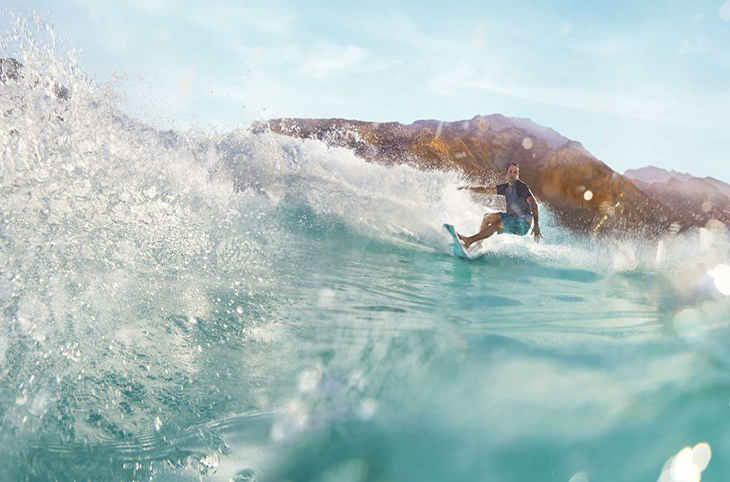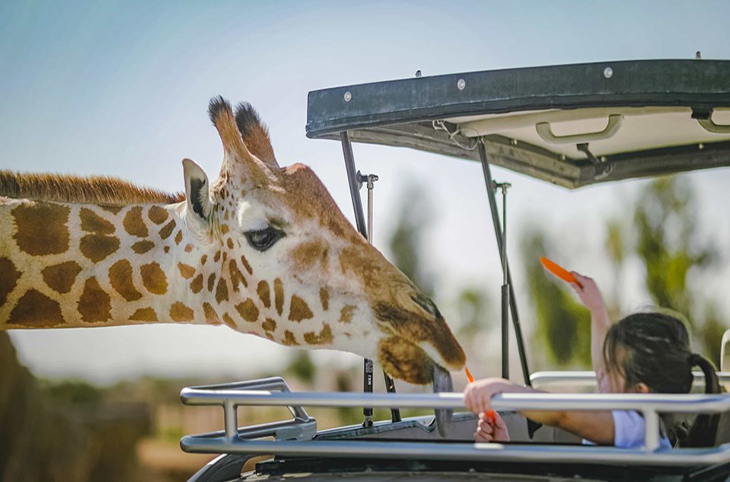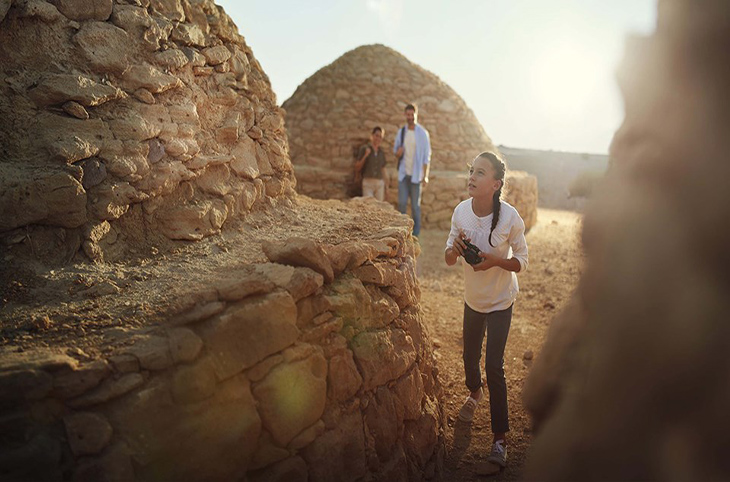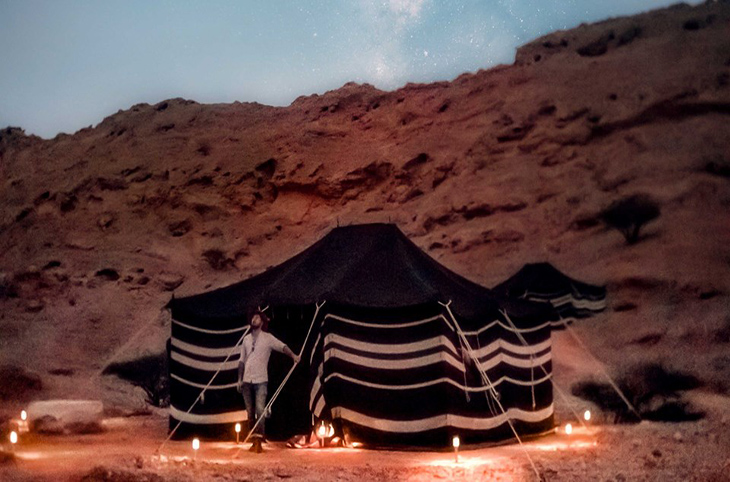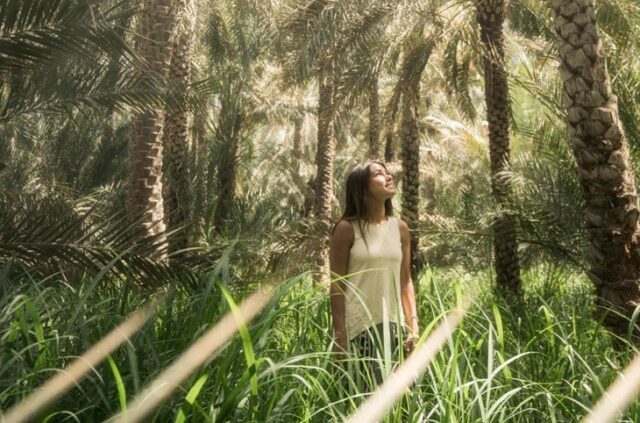Just a 90-minute drive from Abu Dhabi, Al Ain is the capital’s garden city, one of the world’s oldest permanently inhabited settlements and a UNESCO World Heritage Site. Don’t forget your phone when visiting this green region because it’s filled with visual gems and characterful sights perfect for photos. Think lush and ancient oases you can wander through, historical forts, archaeological parks home to ancient artefacts, old-world palaces, charming camel markets, an equestrian, shooting and golf club, and vibrant souks (markets) selling authentic Emirati crafts, spices, carpets, perfumes and more.
Al Ain Oasis
With its still-operational traditional falaj (ancient irrigation system) and meandering pathways shaded beneath a thick canopy of over 147,000 date palms and other fruit trees, Al Ain Oasis is the perfect place to bring family or friends to see what agriculture in this region has looked like for millennia.
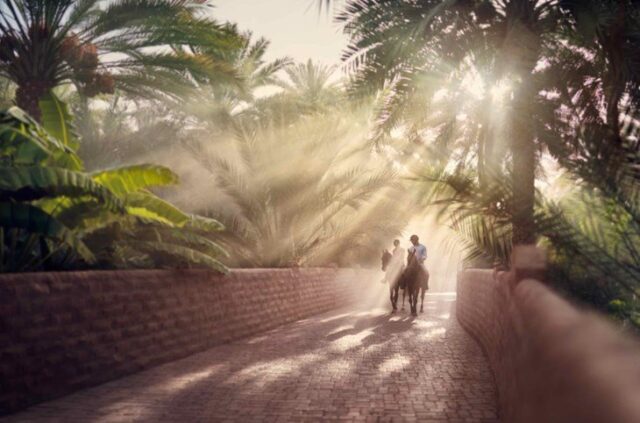
The water supplying the lush oasis comes from both wells and the ancient falaj system that taps distant underground or mountain aquifers and then delivers the water, sometimes over many kilometres, to farms via a system of ground-level and below-ground aqueducts. Al Ain Oasis has plenty of working examples of the falaj that have been used for centuries. There are two main falaj systems serving the oasis: Al Aini and Dawood. They provide water to two separate parts of the oasis and both come from the southeast, the direction in which the Hajar Mountains and the nearby Jebel Hafit mountain lie. Once inside the oasis, water is distributed via an intricate network of channels. Distribution is strictly enforced and implemented by blocking channels in a manner that directs water to the required areas only.
Al Ain Oasis has been a UNESCO World Heritage Site since 2011, but only recently, with the construction of an educational Eco-Centre and the addition of an extensive system of shaded pathways, was it opened to the public. Through a series of immersive interactive exhibits, the Eco-Centre highlights the measures being taken to preserve the delicate oasis ecosystem and celebrates the invaluable contribution that Al Ain’s oasis farmers have made to agriculture through their traditional farming methods.
Qasr Al Muwaiji
For more than 100 years, this incredible historic fort in the lush garden city of Al Ain, about an hour and a half away from Abu Dhabi, has played a major role in the history of the United Arab Emirates. Today, it offers visitors an opportunity to understand the country’s story. Situated at the western approach to Al Ain city, Qasr Al Muwaiji’s picturesque structure is a fine example of early 20th-century mud-brick architecture and a great place to take stunning photographs. The building is a simple but striking form: a square enclosure with projecting corner towers and a grand entrance gate.
Qasr Al Muwaiji was home to generations of the ruling Al Nahyanfamilyand saw the birth of Sheikh Khalifa, Founder of the UAE, in 1948. Built in the time of Sheikh Zayed bin Khalifa the First (r. 1855-1909) by his son, Sheikh Khalifa bin Zayed bin Khalifa, it later became the home and administrative base for the late Sheikh Zayed bin Sultan Al Nahyan when he became the Ruler’s Representative in the Al Ain Region in 1946. His eldest son, His Highness Sheikh Khalifa bin Zayed Al Nahyan, was born at Qasr Al Muwaiji two years later, and spent much of his youth there, learning from his father.

Qasr Al Muwaiji
This UNESCO World Heritage Site functioned not only as a home and oasis in the desert but also as diwan (a council or seat of governance) and a place for the community to gather.
Sheikh Zayed bin Sultan Al Nahyan made many additions to the fort, reflecting its growing importance as the place of government in the region and an important location for discussions, reception of visitors and decision making. He added new diwan buildings and kitchens and expanded guest accommodations to address the increasing number of visitors. The fort’s mosque was also made larger, with Qasr Al Muwaiji’s significance as a focus for the community increasing as people came there to gather, pray and celebrate. When Sheikh Zayed bin Sultan Al Nahyan became Ruler of Abu Dhabi in 1966, both he and his son, His Highness Sheikh Khalifa bin Zayed Al Nahyan, moved to Abu Dhabi. Beginning in the 1970s, the compound underwent several phases of restoration, culminating in a major regeneration project that cemented Qasr Al Muwaiji as an important public space in Al Ain. This architectural gem now offers visitors a variety of historical and traditional experiences associated with the venue, including oral narrations of significant moments from Sheikh Khalifa’s life, from childhood stories to his vast national achievements as leader of the country.

Today, a modern exhibition hall, housed in a beautiful glass-walled space within the courtyard of Qasr Al Muwaiji, tells the story of the fort and its inhabitants, with a focus on His Highness Sheikh Khalifa bin Zayed Al Nahyan, President of the United Arab Emirates. The exhibition sets out the chronology of the members of Abu Dhabi’s ruling family, with a connection to Qasr Al Muwaiji. Above all, it highlights the accomplishments of His Highness Sheikh Khalifa bin Zayed Al Nahyan, tracing the history of Qasr Al Muwaiji from early archaeological discoveries through to modern-day features, and communicating its role in hosting visiting travellers over the ages.
The museum also features interactive activities and performances that celebrate the overall spirit of this significant cultural site.
Displays here also explain the importance of water to Al Ain and its oases, including the nearby Al Muwaiji Oasis, the smallest oasis in Al Ain. Containing approximately 21,000 palm trees, as well as a traditional falaj (ancient irrigation system) that uses ground-level and underground canals to bring water from the nearby mountains, this oasis is a wonderful place to explore with children.
Al Ain Zoo
Families should head to Al Ain Zoo, home to over 4,000 animals, and enjoy up-close giraffe feeding, camel riding and the inviting Elezba petting zoo. This spacious and well-kept zoo is the region’s largest and most acclaimed, with transparent enclosures home to indigenous and exotic species including Arabian oryx, the big-horned Barbary sheep, rhinos, hippos, tigers, lions and more.
This lush zoo’s well-respected conservation and breeding programme protects and preserves rare fauna from extinction, with highlights including a fascinating walk-through lemur experience. There are plenty of green public spaces for picnics, as well as playgrounds, cafés and restaurants to pick up a bite. There’s also a train tour of the wildlife area. Entry to Al Ain Zoo costs AED 30 entry fee for adults and AED 10 for children.
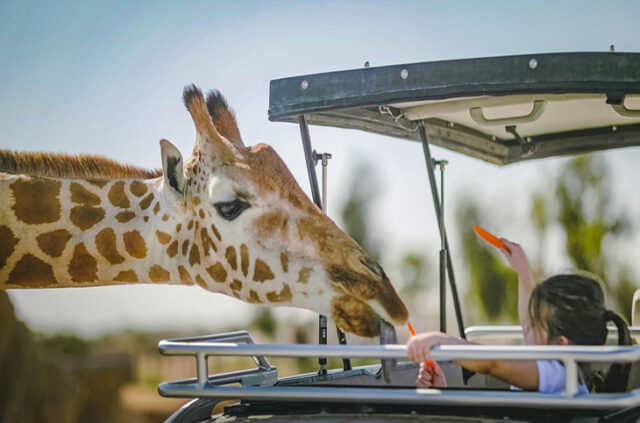
The Sheikh Zayed Desert Learning Centre, housed in the zoo in a beautiful building boasting Leadership in Energy and Environmental Design (LEED) Platinum certification, is a fantastic place to learn more about the UAE’s natural environment. Five interactive galleries showcase the country’s rich history and future-forward ideas, encouraging visitors to reconsider their relationship with the environment and adopt more sustainable lifestyles. For something really unique, book an Al Ain Safari. Led by passionate Emirati guides, it covers an impressive 217 hectares of land along the base of the majestic Jebel Hafit mountain range, offering you a glimpse of African lions, white rhinos, ostrich, zebra, wildebeest, gazelle, kudu, critically endangered or extinct-in-the-wild scimitar oryx, addax and more. In line with the vision of the UAE’s founding father, Sheikh Zayed bin Sultan Al Nahyan, Al Ain Safari plays a prominent role in conservation, setting a benchmark for future conservation projects in the region. End your evening with a Dinner with the Lions, enjoying a sumptuous meal on the edge of the park’s lion territory.
Al Jahili Fort
Since opening its gates in 2008, Al Jahili Fort – set in Abu Dhabi’s lush garden city of Al Ain, about an hour and a half away from the capital – has been a focal point of activities associated with the philosophy, culture and heritage of Abu Dhabi. Al Jahili is one of the largest forts in the UAE, built in the 1890s on the orders of Sheikh Zayed bin Khalifa Al Nahyan, also known as Zayed the First, as the home to members of the ruling Al Nahyan family.

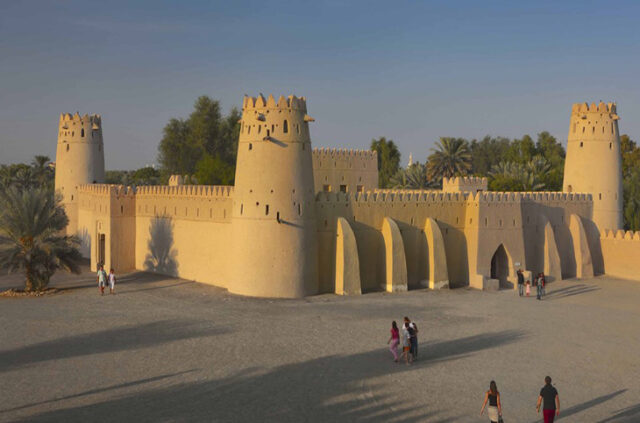
Between 2007 and 2008 the fort was impeccably restored by the Department of Culture and Tourism – Abu Dhabi. Transformed into a cultural centre and tourist attraction, it now houses a permanent exhibition devoted to Sir Wilfred Thesiger, the intrepid explorer, travel writer and photographer who, with his Emirati and Omani companions, crossed the world’s largest sand mass, the Empty Quarter (Rub’ al Khali), twice in the 1940s. Al Jahili Fort is also home to a temporary exhibition gallery. Surrounded by a lush park, this enchanting fort won the prestigious Terra Award for Internal Design and Layout in 2016.
Jebel Hafit Desert Park
Pack a sense of adventure and get ready to immerse yourself in the rich history and incredible landscapes at the one-of-a-kind Jebel Hafit Desert Park in Al Ain, Abu Dhabi’s lush garden city about one and a half hours away from the capital.
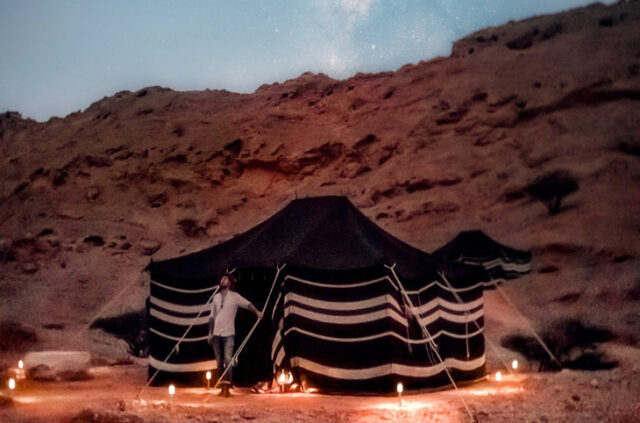
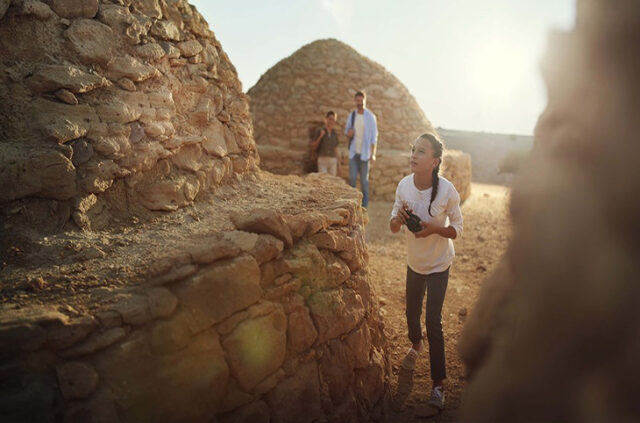
Occupying a nine-kilometre stretch at the base of the craggy Jebel Hafit mountain, Abu Dhabi’s tallest peak, visitors can explore the family-friendly park’s majestic natural surroundings on a hike, mountain bike, horse or camel and discover fascinating archaeological and historical remains that tell enchanting stories of this unique area’s ancient habitation. Archaeological remains include remnants of the Neolithic period from 8,000 years ago, to the 5,000-year-old Jebel Hafit Tombs excavated in 1959 at the request of the late Sheikh Zayed bin Sultan Al Nahyan, Founding Father of the United Arab Emirates.
Wadi Adventure
Wadi Adventure is a fantastic family-friendly adventure park that sits at the base of the majestic and history-rich Jebel Hafit mountain, Abu Dhabi’s tallest peak, about an hour and a half away from the city in Al Ain.

Home to the Middle East’s first man-made white water rafting channels, measuring 1,100 metres in length and perfect for rafting and kayaking, Wadi Adventure also has a surfing wall, wakeboarding facilities, swimming pool and splash pool. Action fans will love the park’s exhilarating aerial adventure course that includes an 18-obstacle, two-level airpark, 1,200-metre long zip line, vertical climb line and 14-metre high giant swing.
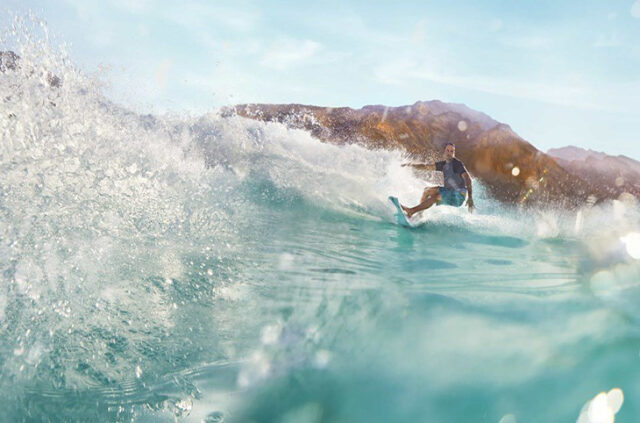
This venue is also a great option for team building and corporate events, with the Summit Events Centre providing a versatile space for meetings and even birthday parties. Sports professionals from around the world regularly visit the park, which also provides training programmes and complete packages including accommodation and airport transfers.
Al Ain Raceway at Al Ain Sportplex
Aside from motorsports, cricket, soccer, paintball and other fun, family-friendly activities, the Al Ain Sportplex is home to the 1.6km Al Ain Raceway, Arabia’s largest go-karting track.

Host to major international events, including the Rotax MAX Challenge Grand Finals, the biggest annual event on the global karting calendar, this fully floodlit circuit features three distinctive configurations, providing an exhilarating challenge for drivers of all abilities. Open to the public, speed lovers can hone their skills in top-of-the-line Intrepid branded rental karts.
A fantastic venue for team building and other corporate events, exclusive use of the circuit needs to be booked in advance.

